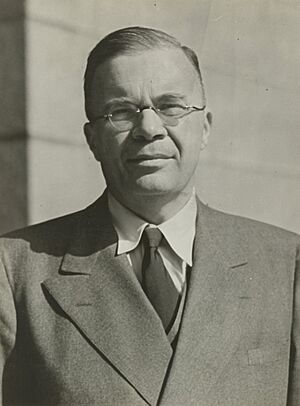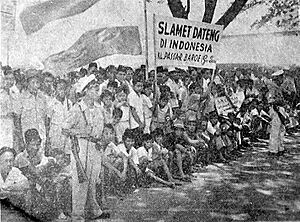Hubertus van Mook facts for kids
Quick facts for kids
Hubertus van Mook
|
|
|---|---|

Hubertus van Mook, c. 1940–1945
|
|
| Lieutenant Governor-General of the Dutch East Indies |
|
| In office 8 March 1942 – 15 October 1948 |
|
| Monarch | |
| Preceded by | Tjarda van Starkenborgh Stachouwer |
| Succeeded by | Louis Beel |
| Personal details | |
| Born |
Hubertus Johannes van Mook
30 May 1894 Semarang, Dutch East Indies |
| Died | 10 May 1965 (aged 70) L'Isle-sur-la-Sorgue, France |
| Alma mater | Leiden University |
Hubertus Johannes "Huib" van Mook (born May 30, 1894 – died May 10, 1965) was an important Dutch leader in the Dutch East Indies (which is now Indonesia). He served as the main leader, called the Acting Governor-General, of the Dutch East Indies from 1942 to 1948. This was a very challenging time, as World War II ended and Indonesia fought for its independence. Van Mook played a key role in these events. He also wrote about Java and its local stories.
Contents
Early Life and Career
Hubertus van Mook was born in Semarang, Central Java, on May 30, 1894. Like many Dutch and Indos (people with both European and Indonesian heritage) who grew up there, he thought of the East Indies as his home. He studied about the East Indies at Leiden University in the Netherlands. After finishing his studies, he returned to the Dutch East Indies.
In 1931, he became a member of the Volksraad. This was a council that advised the Dutch government in the colony. While in the Volksraad, he spoke up for more self-rule for the Dutch East Indies. He also believed that all people should be treated fairly, no matter their background. From 1937 to 1941, he was in charge of economic affairs for the colony.
World War II and Leadership
On December 29, 1941, a special order named van Mook as the next leader after Governor-General Alidius Tjarda van Starkenborgh Stachouwer. He was given the title of Lieutenant Governor-General. This happened just before the Japanese army took over the East Indies in March 1942.
The Dutch East Indies government, which was then in Australia, gave van Mook power over areas not yet taken by Japan. However, two weeks later, he became the Minister of Colonies instead. In September 1944, he convinced the Dutch government to set up a temporary government for the East Indies. He was then made Lieutenant Governor-General again.
Many conservative Dutch people did not trust van Mook's ideas. He was seen as too open to Indonesian nationalism. Because of this, he was never given the full title of Governor-General. After Japan surrendered in August 1945, Australia and Britain helped take back the East Indies. This was because the Netherlands was weakened by the German occupation. Australian forces easily took over the outer islands. But British forces in Java and Sumatra faced challenges from a new Indonesian Republic. This Republic was led by Sukarno and Hatta.
Indonesian National Revolution
On October 1, 1945, Van Mook returned to Java. He came with parts of the Dutch civil administration. However, many Indonesian people were angry about the Dutch returning. They did not want Dutch colonial rule to start again.
Van Mook wanted Indonesia to become independent. But he thought it should be a federal republic. This meant it would be a group of states, not one single country. He also wanted it to have strong ties with the Netherlands. He did not think Sukarno's Republic was strong enough to handle its economy. He also worried about the rising Indonesian Communist Party. So, he started working with Indonesian leaders outside Java. He held meetings to reduce the influence of Sukarno's Republic.
Conflict and Agreements
The Dutch government launched military actions in mid-1947. These were called "police actions" (known as Operatie Product). The Dutch army took over large parts of Java and Sumatra. The Indonesian army could not resist much. However, the UN Security Council and the United States pressured the Dutch to stop. They called for a ceasefire.
This led to the Renville Agreement in January 1948. This agreement said that Indonesian forces should leave Dutch-controlled areas. It also set up a ceasefire line, known as the Van Mook Line. Because of problems with different leaders and opposition from parts of the Dutch military, Van Mook resigned in 1948. After the ceasefire, the Indonesian military secretly returned. They began fighting the Dutch using guerrilla tactics. This led to a second major Dutch military action in December 1948, called Operatie Kraai.
After leaving his role, Van Mook stopped his connections with both Indonesia and the Netherlands. He took a job with the United Nations. He passed away in France not long after.
Awards and Honors
Hubertus van Mook received several important awards during his career. These honors recognized his service and achievements.
| Honours | ||||
| Ribbon bar | Honour | Country | Date | Comment |
|---|---|---|---|---|
| Knight Grand Cross of the Order of Orange-Nassau | Netherlands | 29 August 1947 | Promoted from Commander | |
| Knight of the Order of the Netherlands Lion | Netherlands | |||
| Order of the Jade 3rd class | Republic of China | 22 July 1939 | ||
| Grand Cordon of the Order of the Liberator | Venezuela | 22 August 1944 | ||


